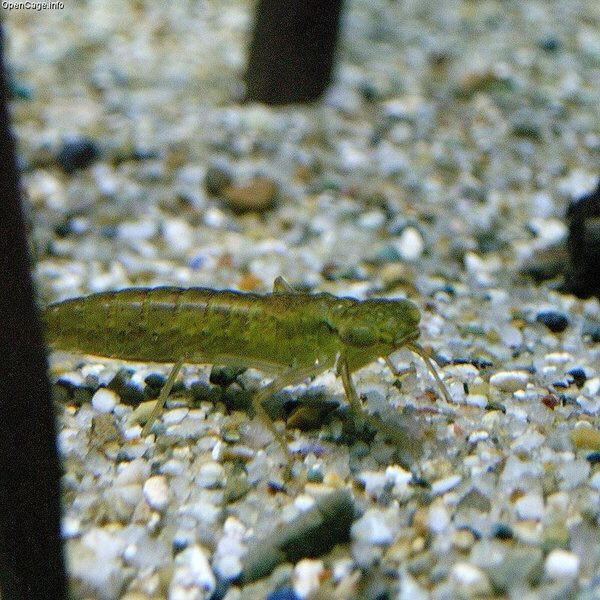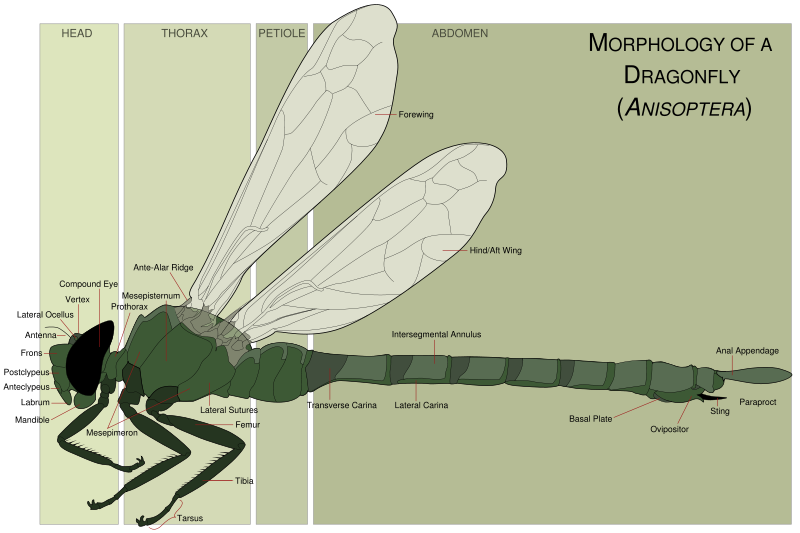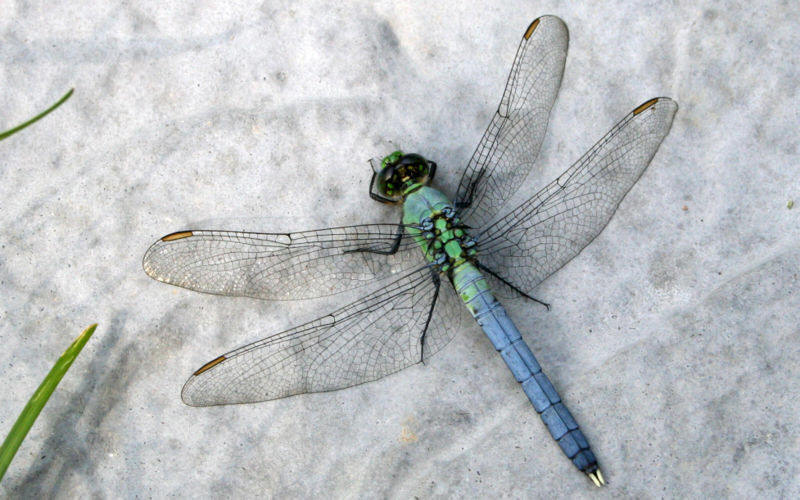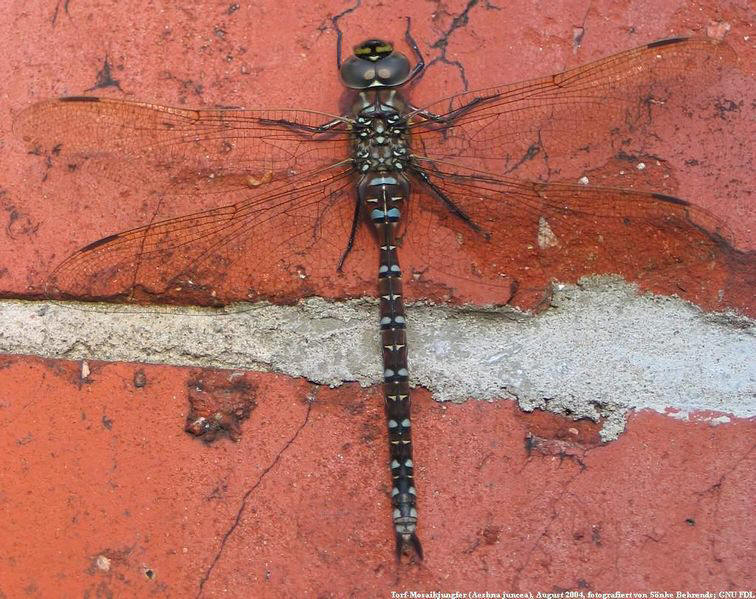Somatochlora hineana
Suborder Anisoptera
This page is intended as a basic introduction to Anisoptera (dragonflies). Its purpose is to familiarize the reader with basic dragonfly anatomy and the general lifecycle of an Anisopteran.
Anatomy
Head: The major part of the head of a dragonfly is the frons, or forehead, which bear a pair of antennae; a pair of large compound eyes; and three simple eyes. The purpose of the simple eyes is debated among entomologists. The strong mouthparts are made up of the labrum, mandible, and labium. The back of the head is called the occiput, and the top is called the vertex. The head is connected to the thorax by a pair of chitinous plates called sclerites, which provide mobility and is often referred to as a "neck." (Silsby, 9)
Thorax: The thorax is the second of the three major
sections of a dragonfly, between the head and abdomen. The thorax harbors
the locomotive organs, which are mainly the wings, and also the appendages.
There are three segments to the thorax, each of which bears a pair of legs.
The two posterior segments also carry the wings. The first segment is
called the prothorax and is covered by a plate called the pronotum. The
posterior two segments are fused and together are refered to as the synthorax.
The frontal surface of the thorax may be decorated with stripes, as well as
decorating the sides, where the stripes are called lateral stripes. The
appendages are well suited for grasping prey and support, but are rarely used
for locomotion. The legs are made up of three sections; the femur, the
tibia, and the tarsus, and end with claws.
 The
wings are generally hyaline, which means clear and transparent, and sometimes
are colored. The wings are strengthened and supported by a membrane of
veins. The patterns of these veins are what is commonly use to separate
and identify families, subfamilies, and genera (Silsby, 9)
The
wings are generally hyaline, which means clear and transparent, and sometimes
are colored. The wings are strengthened and supported by a membrane of
veins. The patterns of these veins are what is commonly use to separate
and identify families, subfamilies, and genera (Silsby, 9)
Abdomen: Ten segments, divided by membranes called
intersegmental membranes, constitute the abdomen. The dorsal surface is
often patterned with spots, bands, central lines, and other marks which are
unique to each species. The segments are numbered one to ten with segment
one being the segment joined to the thorax. The abdomen is long and
slender, and may be highly flexible.
 Anisopteran
males are usually "waisted," meaning that at segment 3, the abdomen begins to
widen and narrows at the point. This can be seen in the picture to the right of
a male Blue Dasher (Pachydiplax longipennis). In female anisoptera,
a straight, stout abdomen is usual. At the end of the male's abdomen are the
anal appendages. These consist of a pair of cerci and a single epiproct.
This set-up is similar to holding your thumb between your first two fingers.
These are used during mating to grasp the back of a female's head (see
lifecycle). Females in the families
Petaluridae, Aeshnidae, and Neopetaliidae have ovipositors at the end of their
abdomen made up of three pairs of of serrated valves and whose functions are to
make slits in plant tissue where the female can then deposit her eggs. In
the family cordulegastridae, ovipositors are unserrated and of simpler
construction. The other families of Anisoptera (Gomphidae, Macromiinae,
Corduliinae, and Libellulinae) bear non-functional ovipositors, since the
females of these families simply scatter their eggs into open water or mud (Silsby,
12).
Anisopteran
males are usually "waisted," meaning that at segment 3, the abdomen begins to
widen and narrows at the point. This can be seen in the picture to the right of
a male Blue Dasher (Pachydiplax longipennis). In female anisoptera,
a straight, stout abdomen is usual. At the end of the male's abdomen are the
anal appendages. These consist of a pair of cerci and a single epiproct.
This set-up is similar to holding your thumb between your first two fingers.
These are used during mating to grasp the back of a female's head (see
lifecycle). Females in the families
Petaluridae, Aeshnidae, and Neopetaliidae have ovipositors at the end of their
abdomen made up of three pairs of of serrated valves and whose functions are to
make slits in plant tissue where the female can then deposit her eggs. In
the family cordulegastridae, ovipositors are unserrated and of simpler
construction. The other families of Anisoptera (Gomphidae, Macromiinae,
Corduliinae, and Libellulinae) bear non-functional ovipositors, since the
females of these families simply scatter their eggs into open water or mud (Silsby,
12).
Lifecycle of Anisoptera
Anisopteran females have two different ways to lay eggs. Those with a
functional ovipositor cut holes into plant tissue at water level and lay their
eggs into the newly made pocket. Species using this method are called
endophytic. Females with incomplete ovipositors are exophytic, meaning
they lay their eggs directly onto the surface of water or ground around water (Silsby,
13). Endophytic eggs are long and cylindrical, while exophytic eggs are broad and
elliptical(Silsby, 15). The eggs hatch into larvae, which is the growth stage of
dragonflies.
 As
with all arthropods, they must continually shed their exoskeleton as it is
outgrown. The stages between such moults are called "instars" or "stadia."
The number of moults depends upon the species but varies between eight and
fifteen times. The habitat of the larvae vary and are roughly broken into
two categories: weed-dwelling and bottom-dwelling, although there are species
which reside in both, and species that reside in neither. Larvae feed on a
variety of matter including fish fry, tadpoles, water beetles, mayfly larvae,
stonefly larvae, and smaller larvae of other odonates (Silsby, 17-19). Larvae are at risk
of predation from many other species also, including fish, newts, frogs, toads,
and larger odonate larvae. One interesting fact is that some larvae feign
death when disturbed, and others will shed a leg or gill if it is grabbed by a
predator; these body parts are replaced over subsequent moults (Silsby, 22). The larval
stage last from six months to five years depending upon the species,
temperature, and food supply. By the time the last instar is mature, it
will have developed all the organs and processes required for adult life as a
winged insect. At this stage, the instar climbs out of the water on some
suitable support such as a stem or branch and aquatic respiration ends as the
larvae begins it's final moult, resulting in a juvenile, aerial dragonfly (Silsby,
22-24).
At this time in their lifecycle,called the teneral stage, dragonflies are
especially susceptible to predation. After waiting to dry off, the
dragonfly will launch into the air and begin its life as an adult. During
the final stage of life, the dragonfly is called an imago. This is stage
during which reproduction takes place (Silsby, 25). The average life expectancy of
dragonflies vary greatly with the species. As a general rule, in temperate
regions, the larval stage is the longest, lasting up to a few years, and the
adult lives only a few months. In tropical species, the larval stage is
reduced to as few as two or thee months and the adult can live as long as a full
year (Silsby, 38)
As
with all arthropods, they must continually shed their exoskeleton as it is
outgrown. The stages between such moults are called "instars" or "stadia."
The number of moults depends upon the species but varies between eight and
fifteen times. The habitat of the larvae vary and are roughly broken into
two categories: weed-dwelling and bottom-dwelling, although there are species
which reside in both, and species that reside in neither. Larvae feed on a
variety of matter including fish fry, tadpoles, water beetles, mayfly larvae,
stonefly larvae, and smaller larvae of other odonates (Silsby, 17-19). Larvae are at risk
of predation from many other species also, including fish, newts, frogs, toads,
and larger odonate larvae. One interesting fact is that some larvae feign
death when disturbed, and others will shed a leg or gill if it is grabbed by a
predator; these body parts are replaced over subsequent moults (Silsby, 22). The larval
stage last from six months to five years depending upon the species,
temperature, and food supply. By the time the last instar is mature, it
will have developed all the organs and processes required for adult life as a
winged insect. At this stage, the instar climbs out of the water on some
suitable support such as a stem or branch and aquatic respiration ends as the
larvae begins it's final moult, resulting in a juvenile, aerial dragonfly (Silsby,
22-24).
At this time in their lifecycle,called the teneral stage, dragonflies are
especially susceptible to predation. After waiting to dry off, the
dragonfly will launch into the air and begin its life as an adult. During
the final stage of life, the dragonfly is called an imago. This is stage
during which reproduction takes place (Silsby, 25). The average life expectancy of
dragonflies vary greatly with the species. As a general rule, in temperate
regions, the larval stage is the longest, lasting up to a few years, and the
adult lives only a few months. In tropical species, the larval stage is
reduced to as few as two or thee months and the adult can live as long as a full
year (Silsby, 38)



